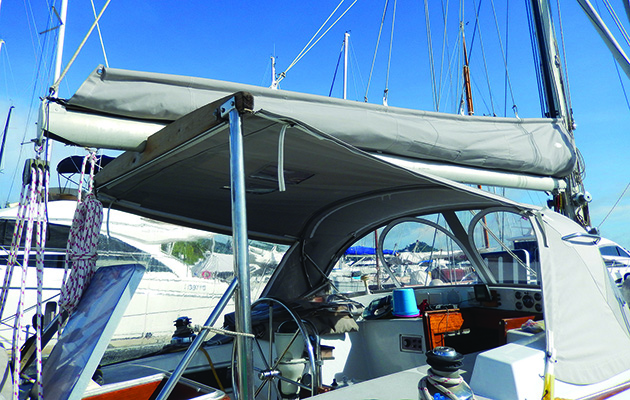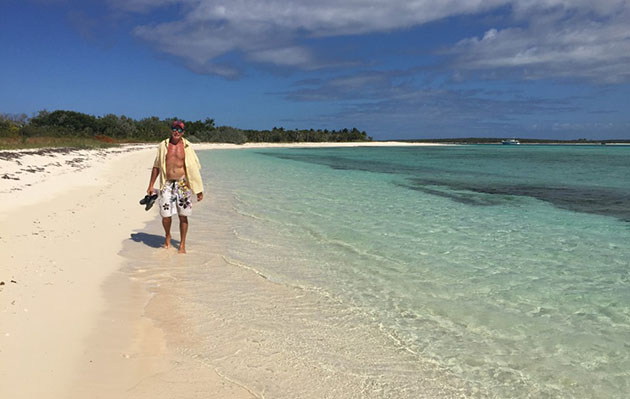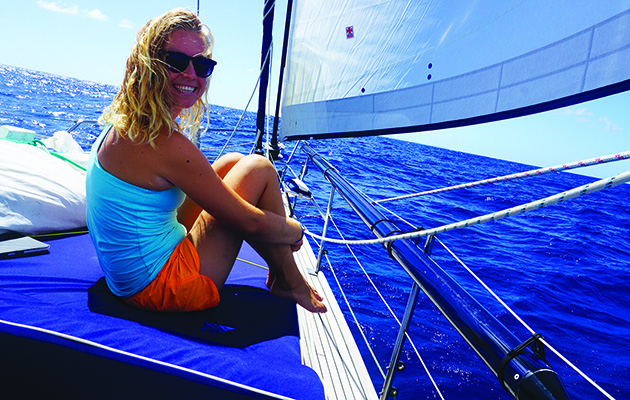Where did the money go?
Analysis of expenditure
The actual cost of cruising for 12 years was £302,549 (excluding the cost of Poco Andante).
As two intrepid accountants, we kept meticulous records during our voyage.

Living aboard and staying at anchor reduced costs
These are the actual costs that have been reconciled back to our bank account, invoice by invoice.
The costs are split into 11 different categories.
1 Living Expenses – 40%
Groceries, provisioning, restaurant and day trips – anything that you would usually spend in your normal life.
2 Boat Equipment – 13%
Associated with big-ticket items of equipment, such as engine, sails, instruments, canvas work, outboards, dinghy, enhancements etc.
3 Marinas & Moorings – 12%
Marina fees and mooring costs
4 Boat Repairs – 12%
This covers the myriad items and spare parts that are used to repair paint and maintain the complicated equipment and machinery in a safe and workable condition.
5 Boat Insurance – 5%
We decided to take out fully comprehensive insurance and had cause to claim three times – and were reimbursed for minor losses and repairs.
These refunds are reflected in the costs of items replaced; only our extra costs are reflected in these figures.
6 Medical – 5%
Medication, dentist, doctor visits, surgery etc.
7 Other – 4%
This has three main items; legal and licenses, training and loss on sale of Poco Andante.
8 Brokerage Fee – 3%
Fee for selling Poco Andanta – at 3% of our total, this was the single largest expenditure (deducted from the sale proceeds).
9 Fuel – 2%
The cost of diesel (the main item) and petrol for the outboards and generator.
10 Comms – 2%
Mainly the cost of mobile telephones and calls.
11 Computing – 2%
Hardware and software, cost of on-board computers.
Boat repairs and maintenance

Repairs in more remote locations were sometimes challenging
It has often been quoted that as a rule of thumb, you should allow 10% of the value of the vessel every year to cover maintenance costs, but it is never clear how this value progresses with time.
Our experience, and that of a number of cruisers, is that when you purchase your vessel, there is a large outgoing whilst you fit the boat out to your specifications.
We made a few major expenditures which included replacing the engine, re-rigging, and installing new instruments.
This added another 24% to our purchase cost.
Over our period of sailing, the boat equipment and repairs averaged 7% of our purchase price.
The costs peaked during major haul-outs in 2005, 2007 and 2011, where it averaged around 8%.
In 2013, after 10 years, items were starting to wear and gear failure started to occur.
For example, our trusty Avon RIB was replaced; the canvas work needed replacement; a major engine rebuild – and other minor items needed to be replaced.
Marinas, moorings and fuel

Living at anchor wasn’t possible everywhere, but we found cheap fuel in Venezuela
The cost of marinas and moorings can be a major outlay and is dependent on the cruising ground.
On the west coast of Spain and Portugal, there are few safe anchorages and it wasn’t until we got to the Caribbean that we found living at anchor feasible – and economic.
We chose to spend some time in New Zealand (2008) and some time in Australia (2009-2013) and kept the yacht in marinas.
This allowed us to work at our professions and we were able to top up our cruising kitty.
Fuel was only 2% of our total costs.
We used 12,235 litres of diesel and the engine ran roughly 4,200 hours, giving an average fuel consumption of 2.93 litres per hour from our 75hp engine.
The average cost came out at £0.51/l, with Elcho Island (off the northern coast of Australia) the most expensive at £1.63/l, and Venezuela £0.01/l the cheapest.
Computing and comms

Mobile phone charges were higher than expected
These days, telephones and computing go hand in hand, with more and more reliance on devices.
When we started out, we had advice from the ‘experts’ who recommended that we use mobile phones as our main form of communication (apart from VHF and HF).
We even put a mobile phone aerial on the top of our mask – which never worked!
With this in mind, we used roaming and maintained our account in the UK.
This was a big mistake – our first six-month bill came to £2,000.
We now buy local pre-paid SIM cards for each country we visit, which is much more economical – and of course, Skype.
In general, we found that most laptops and phones had a two-year life due to the harsh environment.
Living expenses and medical

Provisioning ate a lot of the budget. Credit: James Mitchell/WCC
Living expenses were 40% of the total expenses.
The cost reflects the cost of living in the different countries we visited – and one’s lifestyle.
We did not spend extravagantly but were very comfortable at these levels.
There was a sharp increase in 2009 which reflects our time in Australia where the cost of living was high – and, as we were working, our standard of living went up.
Overall, we spent around £10,000 per annum on groceries, eating out and general living expenses.
We decided to self-insure for our health.
During the early part of our voyage, our spend was low.
However, I needed medical treatment in Australia, which is one reason we stayed so long.
Australia has a reciprocal care agreement with the UK so I benefited from their excellent health service.
The latter years we have been in South-East Asia where health costs are low.
We underwent some minor surgery in Malaysia as well as topping up our medication supply.
The costs are trending higher as we get older.
Other costs

There were also a few costs not included above which are very specific to us – but we will mention them.
We took a few ‘holidays’ from the boat which included overland travel across New Zealand and Australia, South-East Asia and a couple of visits to the UK – this added a further £45,000 to our outgoings.
Also, as mentioned earlier, we had put the contents of our house into storage – a bad mistake as this cost us a total of £15,000 over 12 years.
Funding options
The most common question we are asked is how did we afford to cruise for 12 years.

Making it to idyllic tropical anchorages like Wallilabou on St Vincent made it all worth it
We talked to other cruisers to find out the different methods for funding the cruising lifestyle.
Pensions
This is probably the most common form of funding.
The average cruiser is about 45-65 years of age, and many are receiving pensions from their previous working life and choose cruising as a change of lifestyle.
Investments
If you have been successful in your previous life and have sold the business, or come into an inheritance, or won the lottery, this money can be invested and one can live off the proceeds.
If the income does not cover your costs then the capital will be depleted.
We know a number of long-term cruisers using this funding method, but suffered in the 2008 global financial crisis.
Rental income
Some cruisers live off the rental proceeds from the family home.
This, again, is a common strategy.
Our experience is that maintenance, bad tenants and management fees can reduce this income.
Cruisers who have sold the family home and purchased two or more smaller properties have found this a better strategy.
Writing
With the improvements in communication, writing magazine articles or books and, if you have a second language, translations can all contribute to a modest lifestyle.
We see this as bonus income until you establish a reputation.
Chartering/paying crew
Chartering out your boat or taking on crew for part of the year can easily fund this lifestyle, but becomes a business in its own right – and requires assorted licenses and permits in different parts of the world.
Working
In some countries, it is possible to get working visas so you can mix cruising with working.
If you can work at your profession, you can command a larger income than, say, bar or retail work.
Other cruisers have specific skills which are sought by fellow cruisers or boatyards along the way.
Like most cruisers our funding derived from a mixture of sources:
- 32% pension
- 4% rental income from our family home. This income more or less covered our UK expenses in our absence, for example tax, storage, funding for the children, etc.
- 5% investments
- 59% employment – this paid for our long stays in Australia and New Zealand
Rent out your house – Andy Gibb

Andy Gibb, author of Happy at Work? (Paragon, £9.99) and wife Nicky have rented their house out three times, allowing them to go on three separate long-term voyages, including two Atlantic crossings.
When my wife Nicky and I started to think about doing an Atlantic circuit, we briefly considered selling our house to pay for this sailing, but this would have left us horribly exposed.
Instead, a local estate agent was able to rent out our house and also manage our property.
We not only had a rental income, our tenants paid the bills, and the agent sorted out any problems that cropped up.
When we reached the Med six years later, we told the agents we were coming home and by the time we landed at Heathrow, our house was vacant and ready for us, spotless and pristine after a professional clean.
Renting: Things to consider
Use a reputable agent with a good track record.
They will visit your home and give an estimate of the rent you can expect, and will take references and do credit checks on prospective tenants.
Decide whether you will rent furnished or unfurnished.
If you decide to rent unfurnished, consider where you will store your belongings.
Storage companies are one option, but consider using your loft or a shed, or ask a relative if they have some spare room.
Tell your insurance company that you are renting your home, they will provide a quote for a rented property but also get quotes from a specialist rental insurer.
The agent should deal with utilities and community charge.
Check what right of early return you have if you need to come home early because of unforeseen events.
If you are sailing abroad, you may be a non-resident landlord and rent can be paid to you tax free initially, although you will need to submit a self-assessment later.
On a shoestring – Holly Turner

Four years ago, Holly Turner and boyfriend Simon bought a Colvic Countess 37 for £31,500 before giving up their jobs and setting sail with their dog. Along the way, they started a family and now they manage to keep on cruising on a modest budget.
Our monthly budget for cruising is £600 for a family of two adults, one child and a dog.
Food and provisions form the greatest part of our budget, which includes pet food and nappies, followed by fuel for the inboard and outboard engines, gas for cooking, and laundry, which is only affordable now we are in the USA.
Water and minor repairs also come out of this budget.
Simon and I rent out our properties in the UK and live off the profit.
Keeping costs down
When it comes to provisioning and getting around ashore, we walk everywhere and if it’s too far to walk, we look into local buses to keep costs down.
Eating out in restaurants is a luxury and meals are planned before going shopping so that nothing is wasted.
We don’t use marinas or mooring buoys unless there is no choice.
We undertake all our own maintenance and repairs, including servicing and fixing the engine, antifouling, servicing winches, seacocks and sails.
Check fuel prices and plan in fuel stops on your passage route; the cost of fuel can vary massively from place to place.
On the US east coast, we’ve found the cost can be up to a dollar per gallon cheaper from one town to the next and we hold 100 gallons (380 litres).
Shop around – not everything boat-related comes from a chandlery.
Engine oil can be cheaper from car garages, and look out for secondhand chandlery and boat jumbles.
Be self-sufficient; collect rainwater, use renewable energy, handwash laundry.
A sewing machine is a great piece of kit to have for upholstery and sail repairs.
What we miss
Having money to spend on activities ashore, particularly culture and food.
We’ve visited many amazing places and cities but most of the time we can’t afford to visit the touristy attractions where you have to pay.
The crewing option – Suzanne Van Der Veeken

Suzanne Van Der Veeken is a serial boat hitcher and author of Ocean Nomad (Amazon, £24). Crossing the Atlantic several times on others’ yachts has given her ocean sailing without complication or the cost of ownership.
The complications of purchasing, preparing and running a yacht are the obstacles that ultimately prevent many embarking on a big sailing adventure.
However, the power of the internet has made hitching and shared-cost cruising more accessible than ever.
Online forums and crew-matching websites make finding a berth on someone else’s yacht easy.
Naturally, safety is a big concern, which is why it’s all the more important to spend some time on board before you leave and ideally, go for a sail with the owner.
The nature of your role on board is something that it’s important to establish.
Are you there as amateur crew to learn from an experienced owner skipper?
As a competent and capable watchkeeper that won’t need much mentoring?
Or as someone with a responsible position on board that will look after other crew?
Those not honest about their experience can have a challenging experience offshore.
Agree expectations
Many yachts also operate on a shared-cost basis, so it’s important to establish just what the terms will be from the beginning.
If the yacht is making a profit, it should be commercially equipped.
The rules for this vary from flag state to flag state.
Fundamentally though, boat hitching is a brilliant low-cost way to build your experience and to see if buying a boat would be right for you, and if so, what kind of boat.
There are many different resources online and a community of cruisers that do many trips in this way, and it’s growing year on year.
For me, it’s been a means to do far more than sailing; I’ve met people from all over the world and made some great friends in the process.
For all the latest from the sailing world, follow our social media channels Facebook, Twitter and Instagram.
Have you thought about taking out a subscription to Yachting Monthly magazine?
Subscriptions are available in both print and digital editions through our official online shop Magazines Direct and all postage and delivery costs are included.
- Yachting Monthly is packed with all the information you need to help you get the most from your time on the water.
- Take your seamanship to the next level with tips, advice and skills from our expert skippers and sailors
- Impartial in-depth reviews of the latest yachts and equipment will ensure you buy the best whatever your budget
- If you are looking to cruise away with friends Yachting Monthly will give you plenty of ideas of where to sail and anchor




